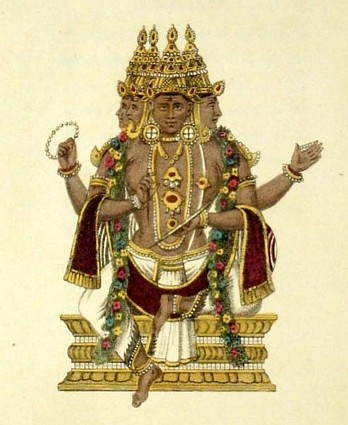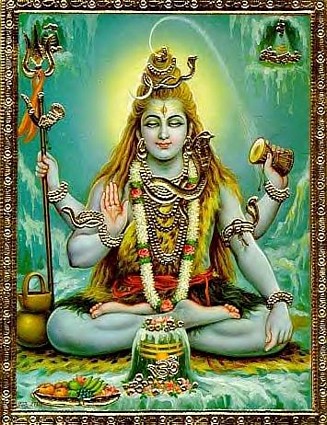The Birth of Lord Ganesha
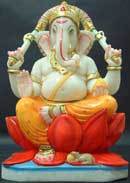

(e-mail March 24, 2010)
My fascination with Hinduism, and its mythology, and the corresponding influence it has on the cultures of Southeast Asia began with a puppet show in Bangkok. We had already traveled for a week in Myanmar and seen lots of Buddhist statues (more about that later) but it was a simple puppet show in Bangkok that was just awesome.
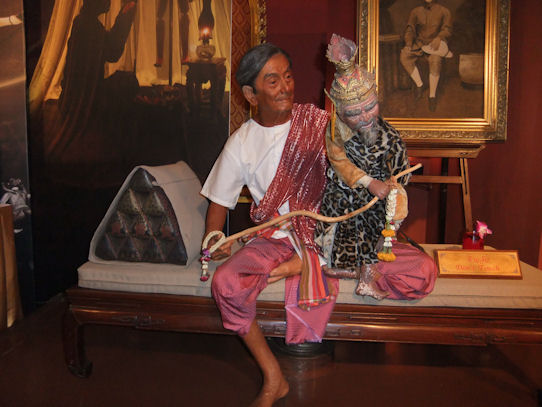
Grand Master Puppeteer Sakorn Yangkhloesot
"Joe Louis"
The Walt Disney of Thai Theatrical Puppetry Hanuman, the Monkey King and
Shiva's consort Parvati
The show has been spinning around in my head since that night and now I am going to share with you the fantastic story of "The Birth of Ganesha" the beloved elephant headed Hindu god. This show won first prize at the World Festival of Puppet Art in Prague in 2006 and 2008.
The first thing to remember is that every boy and girl over the age of 6 knows this story and all the characters just like we know that George Washington chopped down the cherry tree, couldn't tell a lie, and threw an Eisenhower silver dollar across the Potomac River or Abraham Lincoln grew up in a log cabin. In Thailand, we, on the other hand, had to learn these stories with very little cultural background to fall back on. Keeping an open mind is helpful. I will try my best to tell you what you need to know and give you a link to a web page which will give more information if you seek it.
The information you find italicized is not part of the story but will develop the characters or provide some historical background which is necessary to understand the play. Hopefully it will make the whole story more interesting.

(e-mail March 25, 2010)
I guess we have to go back to Daksha to find out who is to blame for Ganesha having the head of an elephant.
As I explored these tales I found that the same gods had many different names depending upon what country you were in. e.g. Shiva is called Isuan in Thailand. I am going to keep it simple and use the same name all the time so you can keep it all straight. You don't have to read the links to my web pages to follow the story. They have been created for those of you who want to learn more than what I have written in my short e-mail messages. By the time I am done I am certain you will be sucked into looking at the links as well.
If you have read my summary of Hinduism you will already know there is a trilogy of Hindu gods:
Lord Shiva, our hero for the moment, is the god of destruction - not bad destruction because he destroys in order to rebuild -- sort of like imploding a casino in Los Vegas to build one bigger and better. But Shiva is also somewhat of a recluse which causes all sorts of problems in heaven. It also means he doesn't have time for such trivial things as love, marriage, children and family. Frequently he has to be pushed or goaded into action. But that is all about to change, and not necessarily for the better.
Sati is the daughter of Daksha who happens to be the son of
Lord Brahma. (Are you keeping this straight now? That's why I like these stories, they make you think and keep guessing.) This means Sati is the granddaughter of Brahma and it is Brahma's wish that Sati marry Lord Shiva. Daksha, on the other hand, wants her to marry someone else. To make a long story short, Sati goes the forest and by her persistence and devotion arouses Lord Shiva and he agrees to marry her. Sati is the perfect wife, devoted explicitly to her husband Lord Shiva. She is looked upon in Hinduism as the perfect example of how married women should conduct themselves. Whenever you see a picture of Sati you will always see Lord Shiva at her side.
But, Lord Shiva's father-in-law, Daksha, is not so happy about this union and things start to get ugly.

(e-mail March 25, 2010)
Daksha was so mad at Sati for marrying Lord Shiva that he threw a party to which he invited all his fellow gods. Part of the party's program included a sacrificial fire where the gods could throw items in sacrifice to Brahma, Daksha's father and, of course Sati's grandfather. Out of spite he didn't invite his daughter Sati or Lord Shiva. Sati just figured he forgot to send them an invitation because they were family and would naturally be welcome and not need a formal invitation. She told Lord Shiva she was going to the party and Shiva tried unsuccessfully to change her mind.
Sati went to the party and Daksha heaped insult upon insult upon Lord Shiva when talking to the other gods at the party. Sati, being the loyal and perfect wife, was horrified at what was happening. She prayed to the gods that she could be reborn to another father who would appreciate her husband for the greatness he was. She then threw herself into the sacrificial fire and was burned to death.
Lord Shiva instantly knew what had happened and went to the party and started killing everyone who was there. He even chopped off the head of Daksha. He was weeping and grieving so much at his loss that he covered himself with the ashes of his beloved and then, loosing control of himself, started the Dance of Death - which meant the Universe would come to an end.
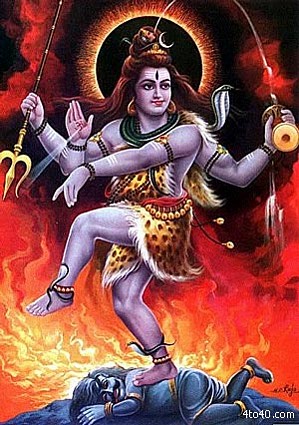 Lord Shiva does the
Lord Shiva does the
Dance of Death

(e-mail March 26, 2010)
After his beloved Sati died and Lord Shiva calmed down he headed deep into the forest where he could be left alone and mourn his loss. He becomes more of a recluse than ever before and didn't pay attention to anything that was going on.
Meanwhile, it doesn't take the demon Taraka long to notice that Lord Shiva is overcome with grief and thus develops a plan to dislodge Lord Shiva as master of the universe.
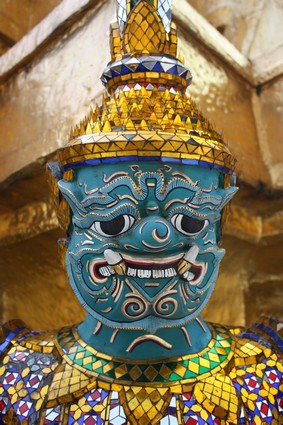 Taraka the Demon
Taraka the Demon
How on earth will the gods pull this one off?

(March 25, 2010)
I am always amazed at the propensity of the human race to develop similar stories and mythology thousands of years and half a world apart. The Greeks had Cupid and on the other side of the world in India the Hindus have Krishna. The names may be different and the stories have a slightly different twist but basically the themes are the same.
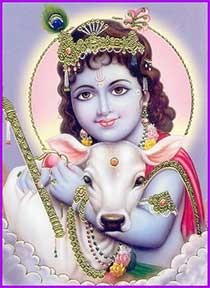 Krishna, god of love Krishna, god of loveHe is the subject of
"The Greatest Love Story of All Times."
 Krishna and Radha
Krishna and Radha
(e-mail March 28, 2010)
When we last left our story Kirshna had shot his flowered arrow of love at Lord Shiva causing him to fall in love with the devoted Pavati, the reincarnated Sati who had loved Lord Shiva so much.
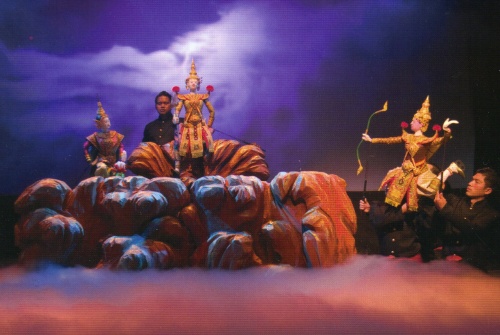
Kirshna shoots his arrow of love at Lord Shiva 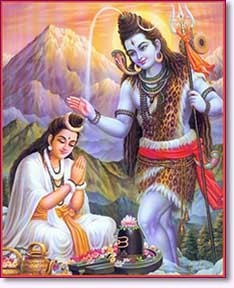 Parvati and Lord Shiva
Parvati and Lord Shiva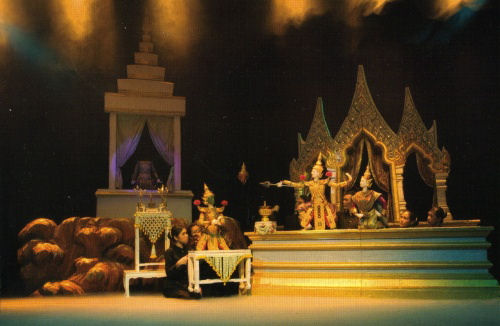 Lord Shiva severs the head of Kumam
Lord Shiva severs the head of Kumam
(e-mail March 25, 2010)
Kumam had his head chopped off by Lord Shiva -- of course Lord Shiva did not know that Kumam was his son because he was born of Parvati, his wife, when he was off on a retreat. Having children was the furthest thing from Lord Shiva's mind. When Kumam's head was chopped off and scattered to the winds Parvati arrives and, horrified by what she sees, begins to weep. She tells Lord Shiva that Kumam was her child - thus his son. As she continues to weep her sorrow gradually changes to anger. Finely the exquisitely beautiful Parvati is metamorphosed into Kali, the goddess of death, a frighteningly hideous and monstrous woman with four arms.
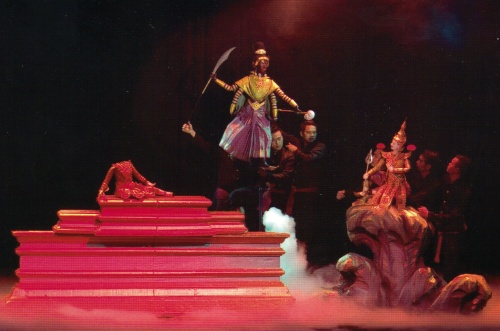 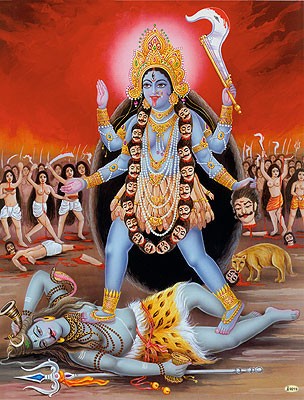 Kali the Terrible
Kali the Terrible
(March 29, 2010)
Lord Shiva, faced with the necessity of placating Parvati and calming Kali, devises a plan to restore Kumam to life. But Kumam's head had been blown apart.... Shiva calls upon his trusted and loyal companion Lord Hanuman, the monkey god.
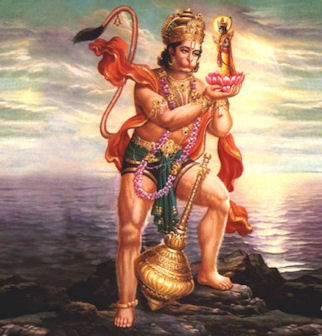
The monkey god
Lord Hanuman
(Hanuman is the son of the goddess Anjana. She was once a celestial maiden & was born as a monkey-woman as a result of a curse. She was living happily with her husband Kesari. When king Dasaratha performed a yagna praying for off-springs, he was yielded a pot of pudding from the fire. A portion of this pudding was carried by the Lord of Winds and fell in the hands of Anjana and she gave birth to a lovely & strong son, Hanuman. Since the Lord of the Winds was responsible for the pudding reaching Anjana, he is also considered the father of Hanuman and gave him the ability to fly.
Hanuman grew up as a strong and mischievous young lad. He could travel as fast as the wind. As soon as Hanuman was born he felt hungry and his mother could not satisfy him. Then he caught sight of the Sun and thinking it was a fruit he leapt after it. The Sun took flight but Hanuman chased him as far as Indra's heaven. Here however, Indra intervened and injured Hanuman's jaw with his thunderbolt. The Lord of the Winds was upset that his son had been attacked and stopped blowing. The whole world was in trouble without winds. All the Gods offered various powerful boons to Hanuman, thus making him more powerful and invincible than before. The Lord of the Winds was pleased & started blowing the winds again.)
Hanuman is given clear instructions from Lord Shiva. "Travel north and bring me the head of the first living thing you find facing west." Hanuman did as he was told and found an elephant with its head pointed in a westerly direction. The elephant's head is severed and taken back to Shiva. By magic Shiva moves the head and connects it with Kumam's body. Kumam comes back to life and Lord Shiva renames him Ganesha.
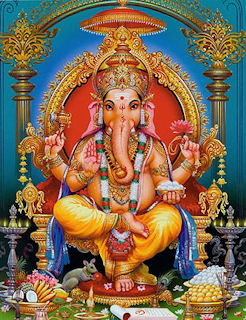 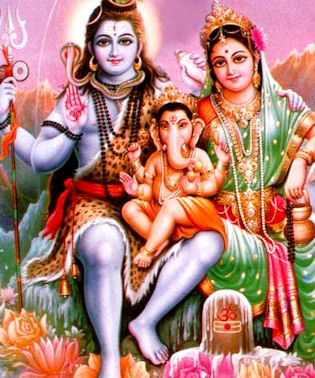 Lord Shiva, Lord Ganesha & Parvati
Lord Shiva, Lord Ganesha & Parvati
Parvati is overjoyed that her son has been restored. (Gods and goddesses don't seem to cared if their relatives had strange appearances. Remember, a long time ago Shiva had restored Sati's father by giving him the head of a goat.)
Wild Applause and Cheering
But the story doesn't end here, remember Taraka and his demon army is still attacking heaven and there is only one person in all the universe that can defeat him. Do you suppose Ganesha the newly born boy with the head of an elephant is up to the task?

(e-mail March 25, 2010)
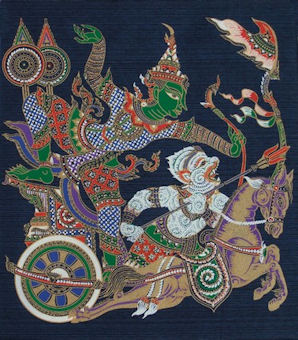
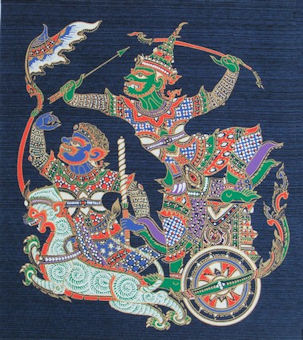 Hunaman leads the charge against Taraka and the demons
Hunaman leads the charge against Taraka and the demons
The celebration of Ganesha's recreation was short-lived, however because the purpose of his birth was yet to be fulfilled. The gods reminded Lord Shiva that only his son could defeat the cursed demon Taraka.
As the battle between the gods and the demons is raging Ganesha arrives to join the fight. Taraka arrives. Taraka and Ganesha engage in a war of words in which Taraka tries to find out who Ganesha is. (You can imagine that there is no family resemblance with Lord Shiva and Ganesha to give Taraka a clue.) Ganesha tells him he is the son of Lord Shiva but Taraka doesn't believe him because he knows Shiva was still mourning Sati's death and thus could not possibly have a child. Taraka insults Ganesha by telling him to go home and play with his toys. Ganesha gets mad and the two engage in battle. Ganesha calls upon Naga for assistance.
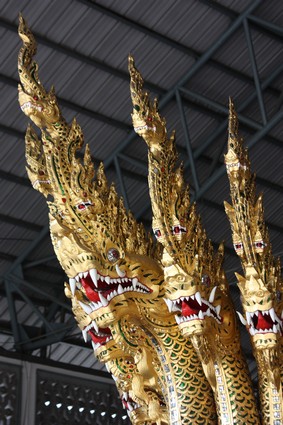 The Naga
The Naga
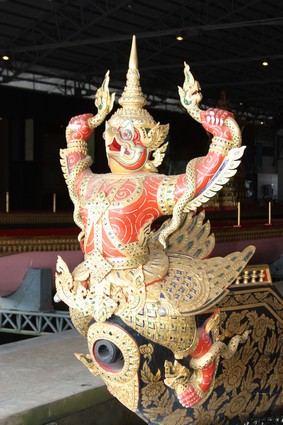
Garuda
Back to our story:
Ganesha orders Naga to coil itself around Taraka and then strikes Taraka with his trident -- remember it is the one Lord Shiva had originally given to Parvati. [These stories get complicated]. Taraka dies and the gods regain control of heaven.
In the final scene of the puppet show Ganesha is seated on Naga. All the gods gather around to pay homage. From that day forward Ganesha is venerated as the god of success and the patron of learning.
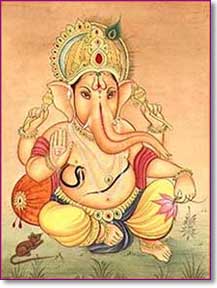 See the little naga wrapped
See the little naga wrapped
around Ganesha's tummy?
(Editor's note, 13 June 2011: This page is now being construction so come back again.)



For more information about our travels write to Belli. Belli.
Since 15 March 2016 you are visitor number
|


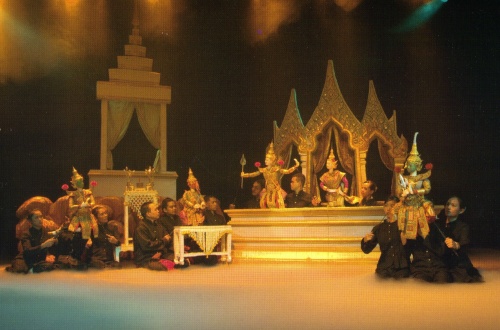
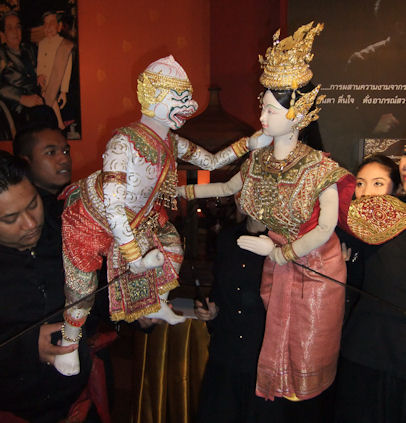
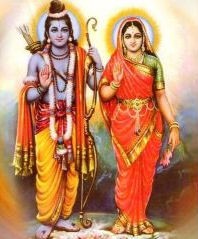

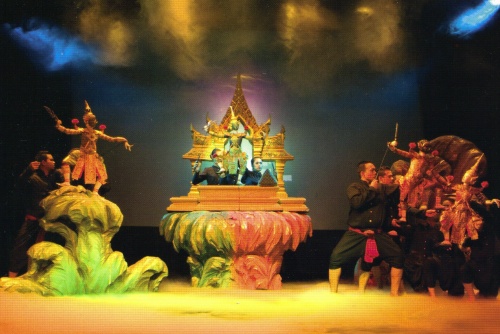

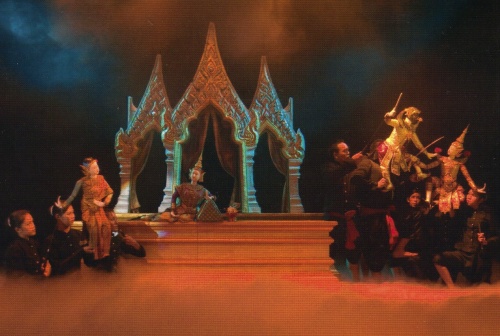




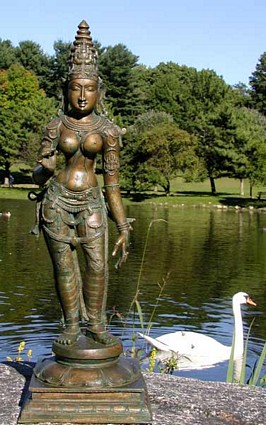











![]()
![]()
![]() Belli.
Belli.
